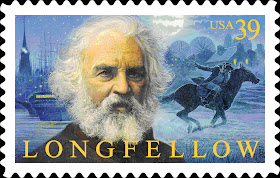The list of authors whose works were reprinted in the pages of Weird Tales reads in part like a who's who of nineteenth-century American literature. I have already covered about half of those authors. I hope to cover the other half over the next few weeks. In chronological order of their births, they are:
- Washington Irving (1783-1859)
- Nathaniel Hawthorne (1804-1864)
- Henry Wadsworth Longfellow (1807-1882)
- Edgar Allan Poe (1809-1849)
- Walt Whitman (1819-1892)
- Fitz-James O'Brien (1828-1862)
- Edmund Clarence Stedman (1833-1908)
- Frank Stockton (1834-1902)
- Mark Twain (1835-1910)
- Sidney Lanier (1842-1881)
- Ambrose Bierce (1842-1914)
- F. Marion Crawford (1854-1909)
- O. Henry (1862-1910)
- Robert W. Chambers (1865-1933)
- Frank Norris (1870-1902)
There are of course well known names absent from the list: essayists, philosophers, Transcendentalists, Abolitionists, political figures, many of the poets. More conspicuously absent are these indispensable authors:
James Fenimore Cooper (1789-1851)-Most of Cooper's works were historical or adventure novels, but I found a reference to a book called The Monikins (1835), about "[a]n Antarctic land of educated monkeys that 'ape' English and American social and political folly." That description makes The Monikins sound more like a satire than a work of fantasy, but it's a book worth mentioning anyway.
Antarctica was discovered in 1820. Cooper's book may or may not have been the first novel of the frozen continent, but it preceded Edgar Allan Poe's Narrative of Arthur G. Pym of Nantucket (1838) by three years. More than half a century later, Jules Verne published a sequel to Poe's novel, Antarctic Mystery: The Sphinx of the Ice Fields (1897). H.P. Lovecraft also referred to Arthur G. Pym in his own Antarctic novel, At the Mountains of Madness (1931), which was rejected by Weird Tales. You can find out more on the author at the website of the James Fenimore Cooper Society, here, and on polar fiction by clicking this link.
Antarctica was discovered in 1820. Cooper's book may or may not have been the first novel of the frozen continent, but it preceded Edgar Allan Poe's Narrative of Arthur G. Pym of Nantucket (1838) by three years. More than half a century later, Jules Verne published a sequel to Poe's novel, Antarctic Mystery: The Sphinx of the Ice Fields (1897). H.P. Lovecraft also referred to Arthur G. Pym in his own Antarctic novel, At the Mountains of Madness (1931), which was rejected by Weird Tales. You can find out more on the author at the website of the James Fenimore Cooper Society, here, and on polar fiction by clicking this link.
Herman Melville (1819-1891)-Herman Melville, friend of Nathaniel Hawthorne, seems not to have written in the genre of weird fiction, but if you have ever read "Bartleby the Scrivener," you probably said to yourself, "Boy, that's weird." There are fantastic elements in other works by Melville. H. Bruce Franklin included the story "The Bell-Tower" in his anthology Future Perfect (1995), calling it "Melville's only complete science fiction." Otherwise Melville wrote mostly about the sea, including in his magnum opus, Moby-Dick, or The Whale (1851). Although Moby-Dick has been adapted many times, the most well-known adaptation is the movie version from 1956 starring Gregory Peck and with a screenplay co-written by Ray Bradbury.
Emily Dickinson (1830-1886)-Of the authors on this list, Emily Dickinson is most aggrieved by not having had her work reprinted in Weird Tales. Could her poems have been too much even for Farnsworth Wright's tastes? Too subtle? Too sophisticated? Too morbid? Too obscure? Or was he simply unable to secure rights to reprint them? And shall I correct the oversight?
Bret Harte (1836-1902)-Bret Harte wrote not Westerns but of the West. Harte also wrote a parody of the Sherlock Holmes stories featuring a detective named Hemlock Jones. And, he may have been connected in the most roundabout way with H.P. Lovecraft through his work for a New Englander named Whipple.
Kate Chopin (1851-1904)-I'm not familiar with Kate Chopin's stories. You may not find any work of fantasy or weird fiction there. All I can say is that she was influenced by Guy de Maupassant, the French teller of tales, some weird, some not.
Charlotte Perkins Gilman (1860-1935)-Of all the authors on this list, only Charlotte Perkins Gilman lived into the Weird Tales era. A feminist and social reformer, she wrote scores of short stories, novels, essays, poems, and lectures. Her most famous work is "The Yellow Wallpaper" (1892), a story of madness and horror that would have been suitable for the Weird Tales crowd. Charlotte also wrote the Utopian novel Herland (1915), sort of a combination of Looking Backward and King Solomon's Mines.
Stephen Crane (1871-1900)-In his brief life, Stephen Crane authored a number of American classics, including The Red Badge of Courage (1895). He also wrote terse, enigmatic, naturalistic--some would say harsh--verse such as this poem from 1895:
A man feared that he might find an assassin;
Another that he might find a victim.
One was more wise than the other.
A few of those poems would have fit in nicely in the pages of Weird Tales.
 |
| "The Night Cafe" from 1888. |
Text and captions copyright 2012, 2023 Terence E. Hanley




























